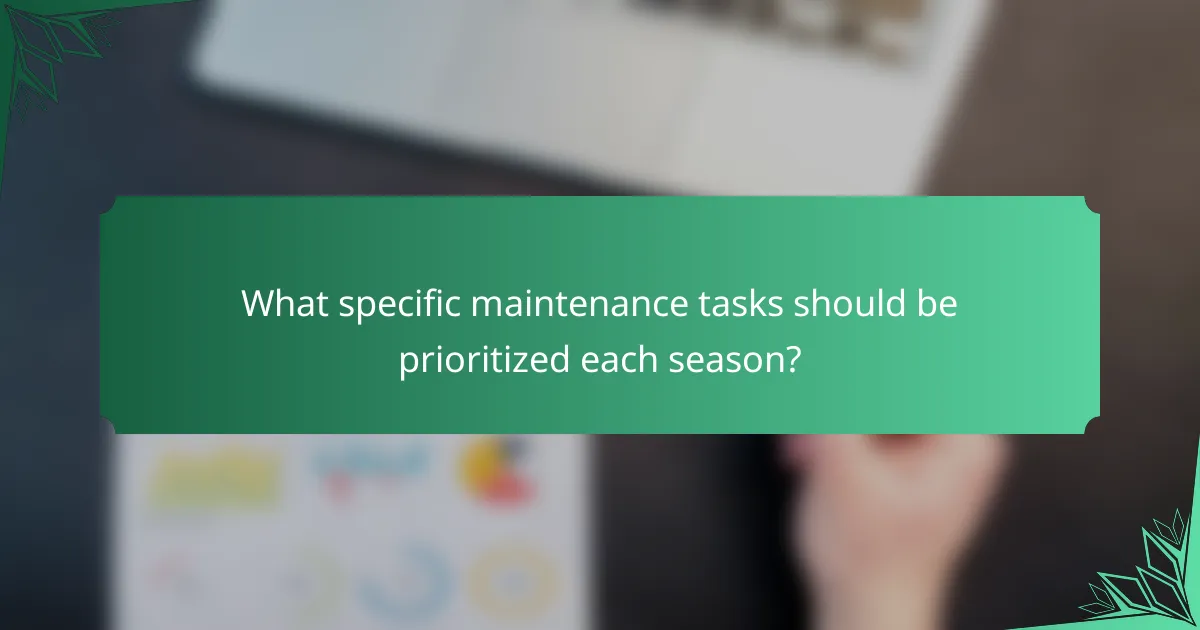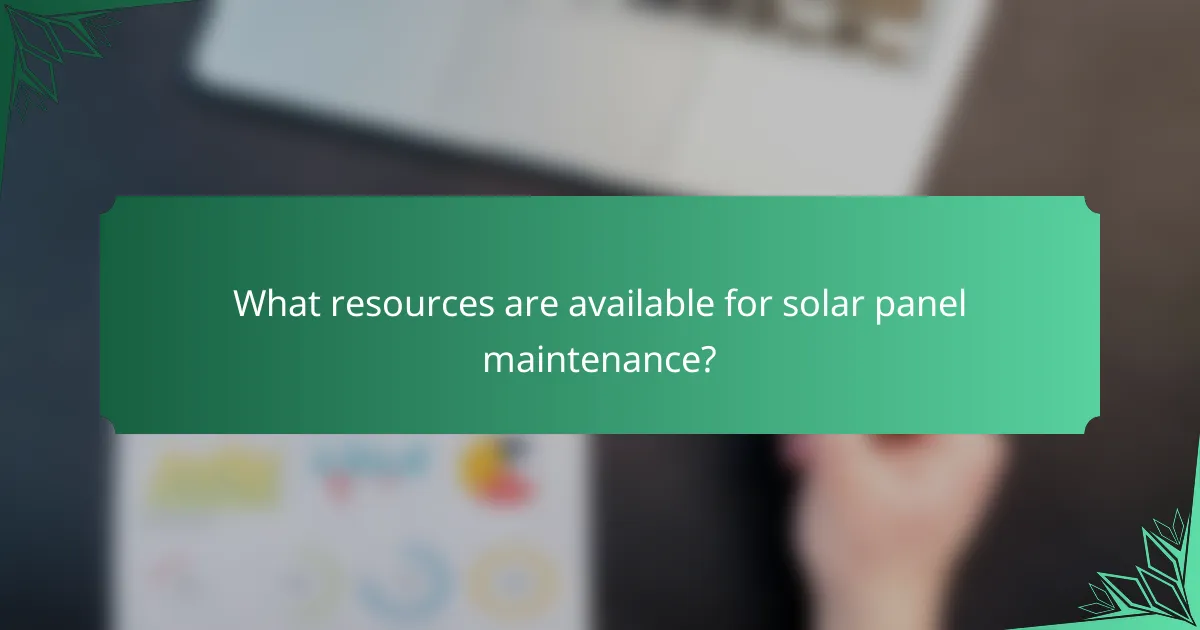
What is a Seasonal Maintenance Checklist for Solar Panels?
A Seasonal Maintenance Checklist for Solar Panels is a structured list of tasks to ensure optimal performance. This checklist typically includes cleaning the solar panels to remove dirt and debris. Inspecting the mounting hardware for any signs of wear is also essential. Checking the inverter for proper functioning is crucial for energy conversion. Monitoring the performance metrics helps identify any drops in efficiency. Reviewing the surrounding landscape for shading issues is important as well. Lastly, scheduling professional inspections can provide a thorough assessment of the system. Regular maintenance can extend the lifespan of solar panels and enhance energy production.
Why is seasonal maintenance important for solar panels?
Seasonal maintenance is important for solar panels to ensure optimal performance and longevity. Regular maintenance helps identify and address issues such as dirt accumulation, shading from vegetation, and potential damage. Clean panels can operate at up to 25% higher efficiency compared to dirty ones. Seasonal checks can prevent small issues from escalating into costly repairs. According to the National Renewable Energy Laboratory, proper maintenance can extend the lifespan of solar panels beyond 25 years. Ensuring that panels are free from debris and functioning properly maximizes energy production. Regular inspections also provide opportunities to check for electrical issues or component wear. Overall, seasonal maintenance is crucial for maintaining the efficiency and reliability of solar energy systems.
What are the potential risks of neglecting seasonal maintenance?
Neglecting seasonal maintenance for solar panels can lead to several risks. These risks include reduced energy efficiency and increased operational costs. Dirt and debris accumulation on panels can block sunlight, decreasing their output. Over time, this can result in significant energy loss. Additionally, failing to inspect for damage can lead to costly repairs. Issues like cracked panels or faulty wiring may go unnoticed. This can compromise the system’s overall performance and lifespan. Regular maintenance helps identify and address these problems early. Without it, the long-term viability of the solar energy system is at stake.
How does seasonal maintenance impact solar panel efficiency?
Seasonal maintenance directly impacts solar panel efficiency by ensuring optimal performance. Regular cleaning removes dirt, dust, and debris that can block sunlight. This blockage reduces energy production significantly. For instance, a study shows that unclean panels can lose up to 25% of their efficiency. Additionally, inspecting for damage helps identify issues before they worsen. Seasonal checks can also optimize angle adjustments for maximum sun exposure. These actions collectively enhance energy output and prolong the lifespan of the solar system.
What are the key components of a seasonal maintenance checklist?
The key components of a seasonal maintenance checklist for solar panels include visual inspection, cleaning, performance monitoring, and electrical connection checks. Visual inspection involves checking for physical damage, debris, or shading on the panels. Cleaning is essential to remove dirt, dust, and bird droppings that can affect efficiency. Performance monitoring tracks energy production to identify any drops in output. Electrical connection checks ensure that all wiring and connections are secure and functioning properly. Regular maintenance can enhance the lifespan and efficiency of solar panels.
What tasks should be included in the checklist for spring maintenance?
Inspect solar panels for dirt and debris accumulation. Clean the panels with water and a soft cloth if necessary. Check for any visible damage or cracks on the panels. Ensure that all electrical connections are secure and free from corrosion. Inspect the inverter for proper operation and any error codes. Trim any overhanging branches that may shade the panels. Review the performance data to identify any significant drops in energy production. Schedule professional maintenance if any issues are detected during the inspection.
What tasks should be included in the checklist for summer maintenance?
The checklist for summer maintenance of solar panels should include cleaning the panels, inspecting for damage, checking electrical connections, and ensuring proper shading. Cleaning the panels removes dirt and debris that can reduce efficiency. Inspecting for damage identifies any cracks or issues that may affect performance. Checking electrical connections ensures all components are functioning correctly and safely. Ensuring proper shading involves trimming any overhanging branches that may block sunlight. These tasks are essential to maintain optimal performance and efficiency during the summer months.
What tasks should be included in the checklist for fall maintenance?
The checklist for fall maintenance of solar panels should include several key tasks. First, clean the solar panels to remove dirt, leaves, and debris. This ensures maximum sunlight absorption. Next, inspect the mounting hardware for any signs of wear or corrosion. Secure any loose components to maintain stability. Additionally, check the electrical connections for any signs of damage or corrosion. This helps in ensuring efficient energy transfer. Evaluate the inverter’s performance and look for any error codes. Regular monitoring can catch issues early. Lastly, trim any overhanging branches that may block sunlight in the winter months. These tasks help maintain the efficiency and longevity of solar panels during the fall season.
What tasks should be included in the checklist for winter maintenance?
The checklist for winter maintenance of solar panels should include several specific tasks. First, remove any snow accumulation from the panels to ensure optimal sunlight exposure. Second, inspect the panels for any damage or debris that may obstruct performance. Third, check the mounting hardware for tightness and corrosion. Fourth, ensure that the inverter is functioning properly and not displaying any error codes. Fifth, clean the panels with a soft brush or cloth to remove dirt and grime. Sixth, monitor the solar energy production to identify any significant drops in efficiency. Lastly, review the warranty and maintenance agreements for any seasonal requirements. These tasks help maintain the efficiency and longevity of solar panels during winter months.
How can homeowners effectively implement the seasonal maintenance checklist?
Homeowners can effectively implement the seasonal maintenance checklist by following a structured approach. First, they should create a detailed checklist specific to solar panel maintenance. This checklist should include tasks such as inspecting for debris, checking for shading, and ensuring electrical connections are secure. Homeowners should set reminders for regular inspections, ideally every three months. They can also document each maintenance task to track progress over time. Utilizing professional services for complex issues is advisable when necessary. Studies show that regular maintenance can increase solar panel efficiency by up to 20%. This emphasizes the importance of adhering to the checklist consistently.
What tools and materials are needed for solar panel maintenance?
Solar panel maintenance requires specific tools and materials. Essential tools include a soft brush or broom for cleaning the panels. A hose with a spray nozzle is necessary for rinsing off debris. A squeegee helps in removing water and preventing streaks. Safety equipment such as gloves and goggles is important for protection. A multimeter is used for checking the electrical output of the panels. Additionally, a voltage tester ensures safe maintenance practices. Lastly, a ladder may be needed for accessing roof-mounted panels. Regular maintenance improves efficiency and extends the lifespan of solar panels.
How often should homeowners review and update their maintenance checklist?
Homeowners should review and update their maintenance checklist at least twice a year. This ensures that all aspects of their solar panel system are functioning optimally. Regular reviews help identify any potential issues before they escalate. Additionally, seasonal changes can impact the performance of solar panels. For instance, debris accumulation may occur during autumn. Furthermore, weather conditions can affect efficiency during winter. By updating the checklist biannually, homeowners can maintain system efficiency and prolong the lifespan of their solar panels.

What specific maintenance tasks should be prioritized each season?
Spring maintenance tasks should focus on cleaning solar panels and inspecting for damage. Dirt and debris accumulate during winter, reducing efficiency. Regular cleaning can improve energy output by up to 20%. Inspect mounting systems and wiring for wear or corrosion. This helps ensure long-term functionality.
Summer tasks should prioritize monitoring system performance and shading issues. High temperatures can affect efficiency. Regularly check inverter readings to ensure optimal operation. Trim any overhanging branches that may cast shadows on panels.
Autumn maintenance should involve another cleaning and checking for fallen leaves. Leaves can block sunlight and reduce energy production. Inspect the system for any signs of wear before winter. This proactive approach can prevent issues during colder months.
Winter tasks include snow removal and checking for ice accumulation. Snow can block sunlight, drastically reducing energy output. Ensure that panels are free of ice to maintain efficiency. Regular inspections during winter can identify any potential issues early.
How do environmental factors influence seasonal maintenance tasks?
Environmental factors significantly influence seasonal maintenance tasks for solar panels. Weather conditions such as rain, snow, and temperature fluctuations affect the frequency and type of maintenance required. For example, heavy snowfall can obstruct solar panels and necessitate snow removal to maintain efficiency. Rain can help clean dust and debris, reducing the need for manual cleaning in certain seasons. Temperature extremes can impact the performance and longevity of solar panel components, requiring inspections and potential replacements. Additionally, seasonal changes in sunlight exposure affect energy production levels, prompting adjustments in maintenance schedules. These factors collectively dictate the timing and nature of maintenance tasks, ensuring optimal solar panel performance throughout the year.
What specific cleaning methods are recommended for solar panels?
Recommended cleaning methods for solar panels include using a soft brush or sponge with mild soap and water. This method effectively removes dirt and debris without scratching the surface. Rinsing with clean water is essential to avoid soap residue. High-pressure washers should be avoided as they can damage the panels. It’s best to clean solar panels during early morning or late afternoon to prevent rapid evaporation. Regular cleaning can improve energy efficiency by up to 20%. According to a study by the National Renewable Energy Laboratory, dirty solar panels can significantly reduce output.
How can homeowners assess the condition of their solar panels seasonally?
Homeowners can assess the condition of their solar panels seasonally by conducting visual inspections and performance evaluations. Regularly checking for dirt, debris, or shading on the panels is essential. Homeowners should also look for physical damage, such as cracks or loose connections. Monitoring the energy output compared to previous seasons can indicate efficiency changes. Cleaning the panels as needed will help maintain optimal performance. Additionally, homeowners may consider hiring a professional for a thorough inspection annually. This practice ensures any underlying issues are identified early. Regular assessments can extend the lifespan of the solar system and enhance energy production.
What common issues should be monitored during seasonal maintenance?
Common issues to monitor during seasonal maintenance of solar panels include dirt accumulation, shading, and physical damage. Dirt can significantly reduce efficiency by blocking sunlight. Regular cleaning can prevent this issue. Shading from nearby trees or structures can also hinder performance. Trimming overgrown vegetation is essential to maintain optimal sunlight exposure. Physical damage, such as cracks or loose connections, should be inspected. These damages can lead to decreased functionality. Additionally, checking for corrosion on electrical components is crucial. Corrosion can affect the overall system performance. Monitoring these issues ensures the solar panels operate efficiently throughout the year.
How can homeowners identify signs of wear or damage on solar panels?
Homeowners can identify signs of wear or damage on solar panels by visually inspecting them for cracks or discoloration. Look for any physical damage on the surface, such as scratches or dents. Check for loose or corroded wiring that may indicate electrical issues. Monitor the performance of the solar panels to detect any significant drops in energy output. Regular cleaning can help reveal hidden damage. Observing unusual noises from the inverter can also indicate potential problems. These signs are critical for maintaining the efficiency and longevity of solar panels. Regular inspections are recommended to catch issues early.
What are the best practices for troubleshooting minor issues?
Identify the minor issue clearly. Examine the solar panel system for visible signs of damage. Check connections and wiring for loose or corroded parts. Inspect the inverter for error codes or warning lights. Clean the solar panels to remove dirt or debris affecting performance. Test the system’s output using a multimeter to ensure proper voltage. Review the installation manual for specific troubleshooting steps. Document any changes or observations for future reference.

What resources are available for solar panel maintenance?
Resources available for solar panel maintenance include professional services, DIY guides, and manufacturer manuals. Professional services offer expert cleaning and inspections. DIY guides provide step-by-step instructions for homeowners. Manufacturer manuals outline specific maintenance requirements for each solar panel model. Online platforms often host forums for user experiences and tips. Local workshops may also teach maintenance techniques. These resources ensure optimal performance and longevity of solar panels.
How can homeowners find professional help for solar panel maintenance?
Homeowners can find professional help for solar panel maintenance by researching local solar service companies. They should check online reviews and ratings for these companies. Homeowners can also ask for recommendations from friends or family who have solar panels. Many manufacturers provide a list of certified professionals for maintenance. Additionally, homeowners can consult local renewable energy associations for trusted service providers. It’s essential to verify the credentials and experience of the professionals before hiring. According to the Solar Energy Industries Association, certified technicians ensure quality service and safety.
What qualifications should be looked for in a solar maintenance professional?
A solar maintenance professional should have relevant certifications and experience in solar technology. Look for certifications such as NABCEP Solar PV Installer or similar credentials. These certifications indicate a standardized level of knowledge and skills in solar panel installation and maintenance. Experience in the field is crucial, ideally with several years of hands-on work. Knowledge of electrical systems and safety protocols is also essential for effective maintenance. Familiarity with local regulations and utility requirements enhances a professional’s capability. Additionally, good problem-solving skills and customer service experience are valuable traits in this profession.
What are some tips for effective seasonal maintenance of solar panels?
Regular cleaning is essential for effective seasonal maintenance of solar panels. Dust, leaves, and debris can accumulate and block sunlight. This buildup can reduce energy efficiency by up to 25%. Inspect the panels for any signs of damage or wear. Look for cracks, loose connections, or corrosion. These issues can affect performance and safety.
Check the inverter to ensure it is functioning properly. A faulty inverter can hinder energy production. Monitor energy output regularly to detect any significant drops in performance. Schedule professional inspections at least once a year. Experts can identify problems that may not be visible during routine checks.
Trim nearby trees and vegetation to prevent shading. Shaded panels can lead to decreased efficiency. Ensure that the drainage system is clear to avoid water accumulation. Water pooling can cause damage over time. Lastly, review the manufacturer’s guidelines for specific maintenance recommendations. Following these tips can enhance the longevity and efficiency of solar panels.
How can homeowners ensure they are following best practices for maintenance?
Homeowners can ensure they are following best practices for maintenance by regularly inspecting their solar panels. Regular inspections allow for the identification of dirt, debris, or damage. Cleaning panels is essential as dirt can reduce efficiency by up to 20%. Homeowners should also check the inverter for any error messages or warning lights. Monitoring energy output can help detect performance issues early. Scheduling professional maintenance at least once a year is advisable. This ensures comprehensive checks and repairs if needed. Keeping records of maintenance activities can help track performance over time. Following manufacturer guidelines for maintenance is crucial for warranty compliance.
What resources can assist in creating a personalized maintenance plan?
Online solar panel maintenance guides provide comprehensive information tailored to specific systems. Websites like EnergySage and SolarReviews offer detailed checklists and tips. Manufacturer manuals are essential for understanding specific maintenance needs. Local solar installers can provide personalized advice based on regional conditions. Community forums allow users to share experiences and solutions. Mobile apps for solar monitoring can help track performance and maintenance schedules. These resources collectively assist in creating an effective personalized maintenance plan for solar panels.
The main entity of this article is the Seasonal Maintenance Checklist for Solar Panels, a structured guide designed to ensure optimal performance and longevity of solar energy systems. The article outlines critical tasks for each season, including cleaning, inspecting for damage, and monitoring performance metrics to maximize energy production. It emphasizes the importance of regular maintenance to prevent costly repairs and enhance efficiency, highlighting specific tasks for spring, summer, fall, and winter. Additionally, it provides resources and tips for homeowners to effectively implement their maintenance plans and identify potential issues.